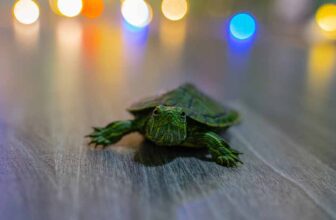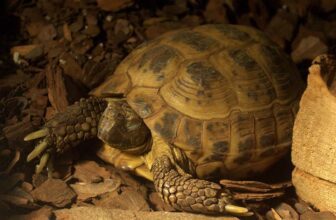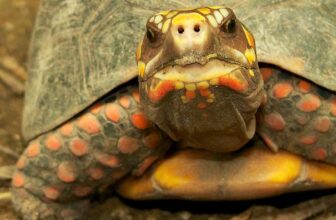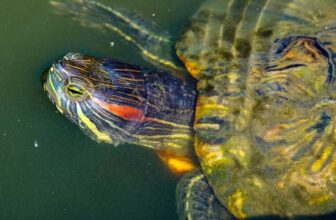The African Spurred Tortoise is also known as the Sulcata tortoise and has its origins in the Sahara Desert in Africa. It’s called a spurred tortoise because it contains sticky-outy bits on its hind legs. These sticky bits are also known as spurs, which explains the reason behind its name. This reptile’s Latin name is Centrochelys Sulcata. Sulcata means furrow in Latin, and it is named thus because of the furrows found on its shells.
This kind of pets are just like any other pet out there, they require a lot of care besides good nutrition, so in the coming lines, we will discover together the top African spurred tortoise food list.
These tortoises are classified as vulnerable by the IUCN (International Union for Conservation of Nature) because their habitats are constantly reducing over the years. The small ones of these Sulcata tortoises are in great demand by pet lovers just like baby bearded dragon. If you plan to keep the African spurred tortoise as your pet, you should understand that it is quite a challenging job.
These tortoises are very active, and they are quite massive in size. The average weight of these tortoises is 200 pounds whereas their average length is 36 inches. Ensure that you have enough space to grow and maintain these tortoises before choosing them as your pets.
The hatchling Salcuta that you buy is very small and cute. You need to keep it in a small 20-gallon aquarium for a few years; however, you need to remember that these tortoises grow at quite a rapid pace if they are cared for properly, and of course, if you follow the following African spurred tortoise food list. After a few years, you need them to very large quarters that accommodate their huge size and active behavior.
African spurred tortoise food list:
The African Spurred Tortoise is mostly a herbivorous reptile. It will be happy feeding on grasses and weeds while grazing on your lawns. While they do eat other insects such as bugs, most of the Sulcatas are quite content eating all types of grasses and weeds with broad leaves. Here are some food items that should form part of your African spurred tortoise food list and regular diet:
- Grass, grass and more of grass
- Dark, leafy greens (kale, green-leaf lettuce, romaine lettuce endive, and escarole are some of the favorite greens of your tortoise) and clover
- Vegetables (mostly carrot, broccoli and bell peppers)
- Small quantities of fruits such as berries (strawberries, blackberries, blueberries, etc.), bananas, melons, pears, and apples can be given occasionally
- A small quantity of collard, mustard and turnip greens can be given occasionally
- Supplemental items such as Bermuda and orchard hay (optional)
- Dandelion greens
- Flowers such as rose Petals, daisy, dahlia, wild rosemary, nasturtium, geraniums, mulberry leaves, grape leaves, and hibiscus
- Cactus pads, nettles, parsley, leaves of strawberry, raspberry, black currant
and blackberry , oregano, etc.
The composition of a sulcata’s diet
Always follow this following ratio when checking your African spurred tortoise food list to be sure that your pet is getting enough nutrients:
- 75% of the diet should contain grass of any form (lawn grass, orchard grass, etc.)
- 25% of the diet should contain weeds, leaves, and flowers that are easily digestible for your pet (clover, dandelion, leaves of various flowers, plantain, etc.)
- Treats should be given in a very minimal quantity. If you have noticed, we
have never allocated a percentage for the number of treats that you canfeed your pet. It should be that minimal! These treats could be in the formof carrots , squashes, pumpkin, dark leafy greens and prickly pear).
Foods to avoid on your African spurred tortoise food list
Never feed your Sulcatas one of the following foods as it may make them sick:
- Dairy products
- Foods meant for cats or dogs
- Corn and all types of grains
- Large quantities of any fruit
- Sugar
- Molasses
- Unnecessary supplements
Top 8 important points to note while feeding your Sulcatas
- African spurred tortoises love their meals, so it is prudent to include a lot of variety in their food. Use different types of greens, fruits, and vegetables on a daily basis to ensure that your Sulcata eats heartily. They also love a lot of color in their foods, so you need to make their meals as colorful as possible. You need to give them very little protein on a daily basis because too much of it can suffocate them.
- Don’t be surprised to see your Sulcatas eating their own You will notice most of the hatchlings do this; however, they get over this habit when they see colorful and different types of food before them.
- The African spurred tortoises are good eaters. Their length and weight bear testimony to this fact. They eat for many hours together on a daily basis.
- Always ensure that you keep the areas surrounding your Sulcata, neat and clean. When there are pieces of paper, plastic or glass lying around, the Sulcata may eat them because they look colorful and attractive.
- Watch out for their physical appearance. Do the scutes on their shells start getting high, in the shape of a pyramid? If yes, you are probably feeding them too much of protein. Do the shells of your pet Sulcata look soft and supple? If yes, they may be suffering from a calcium deficiency. The doctor would advise you to include calcium supplements in the regular meals of your pet, to get rid of this problem.
- While feeding an African spurred tortoise, always keep the meals in a tray or concrete or grass surface. Never keep the food in a dirt-filled area, because your Sulcata may eat the rocks, sand, and dirt on the surface as well along with the meals.
- Use shallow dishes for providing water for the Sulcatas in your outdoor areas. You have to clean these water bowls regularly because these pets tend to soak their meals in the water and also defecate in the same bowl.
- Never give any vitamin or mineral supplements to the Sulcatas without consulting the doctor. More often than not, when you feed them high-fiber and low-protein dishes on a regular basis, they eat well and live an active life. When they are fed a properly balanced diet, hatchlings grow to almost twice their size in just three years.
Conclusion:
So make sure to follow what we have mentioned so far in African spurred tortoise food list if you want your pet to grow healthy. When you follow this African spurred tortoise food list, you can be sure of providing the right quantity and quality of food to your precious Sulcatas.
Frequently Asked Questions:
How long do african spurred tortoises live?
African spurred tortoises, also known as sulcata tortoises, have a lifespan of 70-100 years in the wild, but can live up to 150 years in captivity with proper care and husbandry.
Are African spurred tortoise endangered?
Yes, African spurred tortoises are considered a vulnerable species according to the International Union for Conservation of Nature (IUCN) Red List. Habitat loss, hunting for their meat and shells, and the illegal pet trade are the main threats to their survival in the wild.







20gallon aquarium for a few years!? How? My sulcata has just turned one and has already out grown his enclosure. There’s no way if your giving your sulcata everything they need ( diet, humidity, housing) that you’ll be able to keep them in a small enclosure for a few years. I knew when I got my Angus they grow quick but I wasnt expecting it to be this quick. I’ve spent months building an extension for his table top enclosure and just 8months later he’s making it look extremely small and I’m having to cut bigger doorways and make a ramp so he can come and go, whenever he wants to give him the space he needs. So my advice if you are interested is don’t go for a table top enclosure you need to give them humidity for decent shell growth (to stop pyramiding), youll need a closed top. They grow really really fast if fully cared for, my Angus is putting on 50g minimum extra every month. During April 229g, May 271g and June 359g. As other people have said do not feed the much kale/spinach. Do not feed them parsley or broccoli, and keep fruit to a minimum. Do not buy mercury vapour bulbs, the heat fluctuates too much and they can even blind your tortoise. I use a 100w flood basking bulb which takes care of heat and UVA and a desert tube light that takes care of their UVB.
Check the tortoisetable.org.uk for food lists and for the best advice tortoiseforum.org. these people know what they are talking about and can give you the best advice as fast as you need it. I hope if you do get a sulcata you take care of them too many people don’t and this beautiful animal suffers which is shameful due too their extremely long lifespan.
i have one that just appeared at my home about 30 lbs. what do i do with it ,it seems to want to be near my dogs
How’s it going with your torti?? We’ve recently came upon one as well. Just curious what you’ve found effective.
tell us more
My salcata is 20 years old, weighs 200 pounds and has always been in good health. His previous owner fed him ears of corn, and it is his favorite food. He leaves nothing behind. I’ve read that it is bad for him in a few different places, but when he’s cold and doesn’t want to eat, corn is just the thing. *shrug*
any updates about its diet
Kale, spinach, broccoli and a few others actually are not good for them. It does something to there body where it make there calcium low.
Broccoli and Kale and other brassicas should not be fed to sulcatas.
can you more explain?
I heard the same thing. Cruciferous vegetables uch as cauliflower, cabbage, kale, broccoli, and Brussels sprouts should not be fed to sulcatas. I have a sulcata care guide and it mentions that there is something in cruciferous vegetables that is toxic to tortoises. But maybe in small doses it might be fine??
just stick to the guide. And avoid every little thing that could lead your pet into a real danger